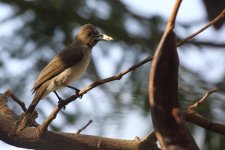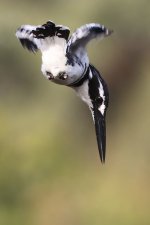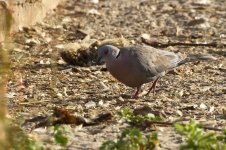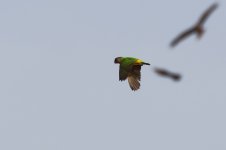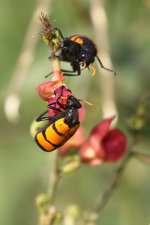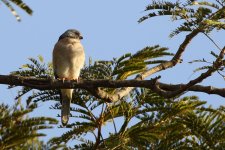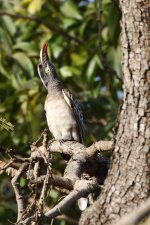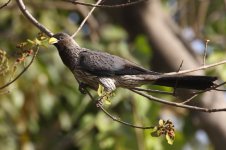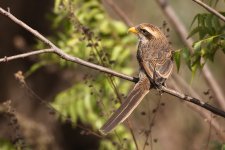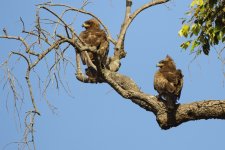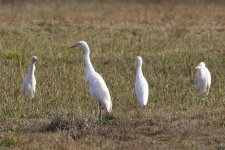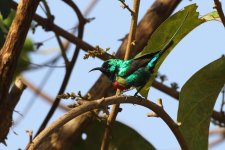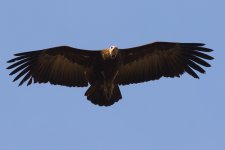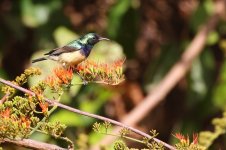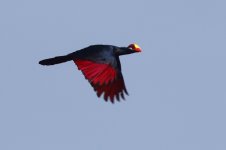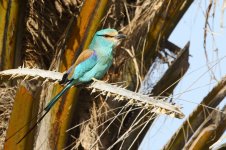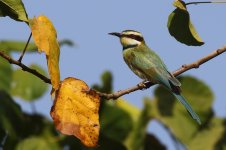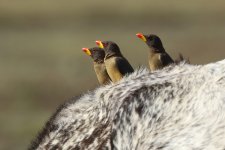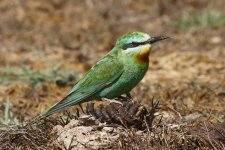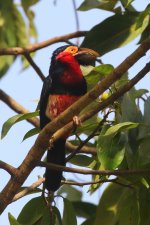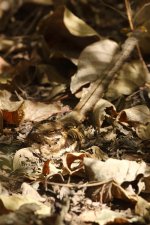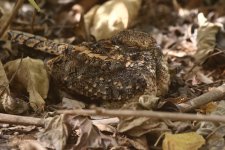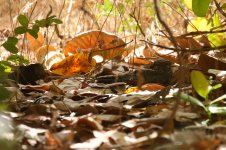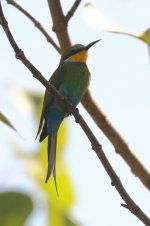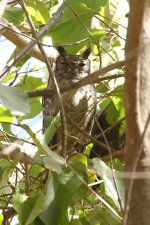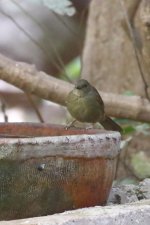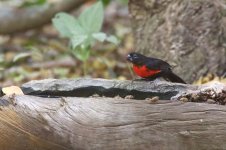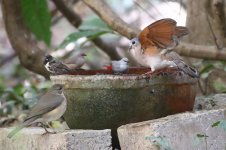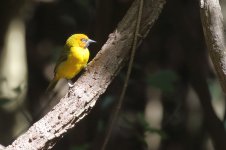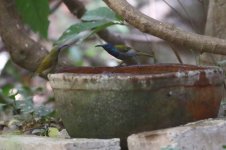Farnboro John
Well-known member
By comparison with some BFers I am not a great traveller, but I do enjoy looking round other countries and continents, and of those latter I've been to so far Africa gets my vote. Much of it, though hot, is not sultry (which I don't like) and it has a splendid array of birds. So when a proposal was floated to tempt my friend Clare into proper foreign travel instead of just messing about in Europe and the Med, I was happy to go along with it: and Gambia seemed tailor-made, not too far, no jet-lag worries, good hotels and guides.
Cast:
Me
Marion
Steve Davis
Clare Dell
(This is a not unusual twitch crew in UK, so we all had a fair idea we could put up with each other for a week.)
Ebrima Sidibeh (guide)
Karanta (driver and secondary guide)
Via The Gambia Experience we booked a half-board week at the Bakotu Hotel, which backs onto the Kotu Creek which is a cracking birding habitat in its own right.
Within that week we had an overnight trip up-river by car, crossing to the North Bank via the new bridge for a look round some areas of special interest.
I haven't yet had Steve's list of sites, so I'm going to start without it and hope he comes through before I've had to say I don't know where we were too many times....
I'll try to remember to embolden first mention of trip birds throughout. At the end I should be able to attach an Excel trip list.
Day One 7 January 2020
A pre-booked taxi picked all four of us up for a whiz round the M25 to the M23 and Gatwick. After the usual nerves going through bag drop, security etc we had time for a decent breakfast and the traditional per-flight G&T before heading off to board our Titan Air A320 for a six-hour flight to Banjul.
Its not easy to enjoy a six-hour flight but good weather and a window seat gave me the chance to see very little snow on the Spanish mountains and a constant brisk wind blowing Sahara sand into the air and coastwards all the way down the West of Africa. In between times I read the field guide and wondered what sort of inroads we would be able to make into it.
When we reached Banjul it was pretty hazy but obviously also a pretty hot afternoon. We turned over the sea to begin an approach across the city to the international airport, and I began scanning the airspace and ground to try to get Bird No. 1 for the trip list.
A couple of kites (presumed Yellow-billed but not positively ID'd) whipped past the wingtip, and I was just beginning to idly wonder just how many raptors might be aloft over the city just now, when the pilot stuffed everything into a corner: throttles up, stick back, double clunk as the undercarriage locked back up - screaming from (some of) the ladies and a whole flock of Hooded Vultures shot past us really rather close. Probably on both sides, but I couldn't see to starboard....
Back up and around we went, with Captain Speaking coming on to explain he'd felt the need to abandon the approach, no need to worry, quite normal...
My first ever airline go-round: how many, in how many trips, have you had? I've flown enough to consider that whatever it is, normal it ain't!
Anyway, it crossed my mind that airline procedures involve essentially doing the same thing, the same way, time after time - so our next approach would involve putting the aircraft through the exact airspace that had previously been full of vultures and hoping that this time it wasn't. What was that definition of madness again?
We landed without further incident. Bird #1: Hooded Vulture. As we taxied in there were definite Yellow-billed Kites hunting the airport outfield.
The terminal had Speckled Pigeons sitting on it, along with the inevitable Feral Pigeons. NOT Rock Doves: assorted plumages of nasty placcies. There was a Blue-cheeked Bee-eater, too. We got through immigration and found our transfer coach to the hotel, unfortunately the baggage handlers had been onto our bags like lightning and we ended up paying them off while resolving not to get caught that way again (and we didn't.)
The Gambia Experience chap had a nice little spiel but we had our own guide booked and a busy birding itinerary so we paid very little attention, gazing out of the coach window to find birds instead.
Laughing Dove, Abyssinian Roller (tick), Blue-bellied Roller (tick), Cattle Egret and Grey Heron had all joined the list by the time we reached the hotel, plus a Nile Monitor swimming in Kotu Creek as we passed over the bridge, initially misidentified as an otter. Oops.
Around Reception an African Mourning Dove was sat in a tree and Common Bulbuls were scrounging. Having found our rooms and frankly, dumped the gear, we set off back to the Kotu Bridge to meet Ebrima and to do some proper birding. We fended off a few offers of guiding with Ebrima's name, which we found to be universally effective all week.
Around the bridge we quickly added Beautiful Sunbird (tick), Wattled Lapwing, African Palm Swift, Western Plantain Eater (tick), Senegal Coucal (tick) and Red-eyed Dove to the list, as well as encountering Ebrima by the Gambian Bird Guide Association office. A bit of hand-shaking and smiles all round, and he suggested a walk along a nearby nature trail.
We assented, but first we had to get our fill of the contents of the creek from the bridge. This included such goodies as Senegal Thick-knee and Vinaceous Dove (both ticks) as well as familiar birds like Spur-winged Plover, Black-winged Stilt, Ringed and Little Ringed Plovers, a Whimbrel, Common Sandpiper, Redshank, Greenshank, a huge adult Caspian Tern fishing in the channel, and a Reed Cormorant overhead.
Cameras were clicking nicely! This was my first trip with 100-400 Mk II as main lens rather than my 500 f4 and I have to say I only rarely missed the extra reach while shooting from the shoulder rather than a tripod unquestionably got me a lot of shots from brief opportunities.
More in a bit (and some photos). Maz says I've been on the computer too long.
John
Cast:
Me
Marion
Steve Davis
Clare Dell
(This is a not unusual twitch crew in UK, so we all had a fair idea we could put up with each other for a week.)
Ebrima Sidibeh (guide)
Karanta (driver and secondary guide)
Via The Gambia Experience we booked a half-board week at the Bakotu Hotel, which backs onto the Kotu Creek which is a cracking birding habitat in its own right.
Within that week we had an overnight trip up-river by car, crossing to the North Bank via the new bridge for a look round some areas of special interest.
I haven't yet had Steve's list of sites, so I'm going to start without it and hope he comes through before I've had to say I don't know where we were too many times....
I'll try to remember to embolden first mention of trip birds throughout. At the end I should be able to attach an Excel trip list.
Day One 7 January 2020
A pre-booked taxi picked all four of us up for a whiz round the M25 to the M23 and Gatwick. After the usual nerves going through bag drop, security etc we had time for a decent breakfast and the traditional per-flight G&T before heading off to board our Titan Air A320 for a six-hour flight to Banjul.
Its not easy to enjoy a six-hour flight but good weather and a window seat gave me the chance to see very little snow on the Spanish mountains and a constant brisk wind blowing Sahara sand into the air and coastwards all the way down the West of Africa. In between times I read the field guide and wondered what sort of inroads we would be able to make into it.
When we reached Banjul it was pretty hazy but obviously also a pretty hot afternoon. We turned over the sea to begin an approach across the city to the international airport, and I began scanning the airspace and ground to try to get Bird No. 1 for the trip list.
A couple of kites (presumed Yellow-billed but not positively ID'd) whipped past the wingtip, and I was just beginning to idly wonder just how many raptors might be aloft over the city just now, when the pilot stuffed everything into a corner: throttles up, stick back, double clunk as the undercarriage locked back up - screaming from (some of) the ladies and a whole flock of Hooded Vultures shot past us really rather close. Probably on both sides, but I couldn't see to starboard....
Back up and around we went, with Captain Speaking coming on to explain he'd felt the need to abandon the approach, no need to worry, quite normal...
My first ever airline go-round: how many, in how many trips, have you had? I've flown enough to consider that whatever it is, normal it ain't!
Anyway, it crossed my mind that airline procedures involve essentially doing the same thing, the same way, time after time - so our next approach would involve putting the aircraft through the exact airspace that had previously been full of vultures and hoping that this time it wasn't. What was that definition of madness again?
We landed without further incident. Bird #1: Hooded Vulture. As we taxied in there were definite Yellow-billed Kites hunting the airport outfield.
The terminal had Speckled Pigeons sitting on it, along with the inevitable Feral Pigeons. NOT Rock Doves: assorted plumages of nasty placcies. There was a Blue-cheeked Bee-eater, too. We got through immigration and found our transfer coach to the hotel, unfortunately the baggage handlers had been onto our bags like lightning and we ended up paying them off while resolving not to get caught that way again (and we didn't.)
The Gambia Experience chap had a nice little spiel but we had our own guide booked and a busy birding itinerary so we paid very little attention, gazing out of the coach window to find birds instead.
Laughing Dove, Abyssinian Roller (tick), Blue-bellied Roller (tick), Cattle Egret and Grey Heron had all joined the list by the time we reached the hotel, plus a Nile Monitor swimming in Kotu Creek as we passed over the bridge, initially misidentified as an otter. Oops.
Around Reception an African Mourning Dove was sat in a tree and Common Bulbuls were scrounging. Having found our rooms and frankly, dumped the gear, we set off back to the Kotu Bridge to meet Ebrima and to do some proper birding. We fended off a few offers of guiding with Ebrima's name, which we found to be universally effective all week.
Around the bridge we quickly added Beautiful Sunbird (tick), Wattled Lapwing, African Palm Swift, Western Plantain Eater (tick), Senegal Coucal (tick) and Red-eyed Dove to the list, as well as encountering Ebrima by the Gambian Bird Guide Association office. A bit of hand-shaking and smiles all round, and he suggested a walk along a nearby nature trail.
We assented, but first we had to get our fill of the contents of the creek from the bridge. This included such goodies as Senegal Thick-knee and Vinaceous Dove (both ticks) as well as familiar birds like Spur-winged Plover, Black-winged Stilt, Ringed and Little Ringed Plovers, a Whimbrel, Common Sandpiper, Redshank, Greenshank, a huge adult Caspian Tern fishing in the channel, and a Reed Cormorant overhead.
Cameras were clicking nicely! This was my first trip with 100-400 Mk II as main lens rather than my 500 f4 and I have to say I only rarely missed the extra reach while shooting from the shoulder rather than a tripod unquestionably got me a lot of shots from brief opportunities.
More in a bit (and some photos). Maz says I've been on the computer too long.
John






